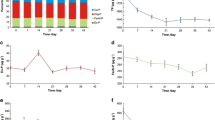Abstract
The aerobic decomposition of the green alga Chlamydomonas reinhardii by a mixed population of lake bacteria was studied in batch and chemostat cultures. Bacterial chemostats were supplied with continuously heatkilled algae. The dead algae rapidly released most of their phosphorus as SRP. In the batch experiments bacteria acted as consumers of the released algal phosphorus. This phosphorus uptake was dependent on the C:P ratio of the algae. During the death phase of the bacteria most of the bacterial phosphorus itself was released. The continuous supply of energy in form of dead algae in the chemostat experiments prevented the death phase of the bacteria and thus any net regeneration of phosphorus. The influence of the C:P stoichiometry of algae and bacteria on the regeneration of algal phosphorus is discussed.
Similar content being viewed by others

References
Bloesch, J., P. Stadelmann & H. Bührer, 1977. Primary production, mineralization and sedimentation in the euphotic zone of two Swiss lakes. Limnol. Oceanogr. 22: 51–526.
Bührer, H., 1979. Der Einfluss von Kohlenwasserstoffen auf die Oekologie der Bakterien im aeroben Seesediment. Schweiz. Z. Hydrol. 41: 315–355.
Bowen, H. J. M., 1966. Trace elements in biochemistry. Academic Press, N.Y.
Currie, D. J. & J. Kalff, 1984. A comparison of the abilities of freshwater algae and bacteria to acquire and retain phosphorus. Limnol. Oceanogr. 29: 298–310.
DePinto, J. V. & F. H. Verhoff, 1977. Nutrient regeneration from aerobic decomposition of green algae. Envir. Sci. Technol. 11: 371–377.
Dicks, J. W. & D. W. Tempest, 1966. The influence of temperature and growth rate on the quantitative relationship between potassium, magnesium, phophorus and ribonucleic acid of Aerobacter aerogenes growing in a chemostat. J. gen. Microbiol. 45: 547–557.
Foree, E. G., W. J. Jewell & P. L. McCarty, 1970. The extent of nitrogen and phosphorus regeneration from decomposing algae. In S. H. Jenkins (ed.), Advances in Water Pollution Research 2. Pergamon Press, Oxford: III-27/1–27/15.
Gächter, R. & J. Bloesch, 1985. Seasonal and vertical variation of the C/P ratio in suspended and settling seston of lakes. Hydrobiologia 128: 193–200.
Golterman, H. L., 1964. Mineralization of algae under sterile conditions or by bacterial break down. Verh. int. Ver. Limnol. 15: 544–548.
Golterman, H. L., 1973. The role of phytoplankton in detritus formation. Mem. Inst. Ital. Idrobiol. 22 suppl.: 89–103.
Hirsbrunner, M., 1981. Chemostatanlage zur kontinuierlichen Kultur von Algen. Schweiz. Z. Hydrol. 43: 370–376.
Johannes, R. E., 1968. Nutrient regeneration in lakes and oceans. In M. R. Droop & E. J. F. Wood (eds), Advances in Microbiology of the the Sea, 1. Academic Press, Lond.: 120–132.
Morowitz, H. J., 1968. Energy flow in Biology. Academic Press, N.Y.
Overbeck, J., 1974. Microbiology and chemistry. Mitt. int. Ver. Limnol. 20: 198–228.
Overbeck, J., 1977. Praktikumsanleitung für den Limnologie-Kurs, 7. Semester. Max Planck-Institut Plön, W. Germany: 27–29.
Reichardt, W., 1971. Catalytic mobilization of phosphate in lake water and by Cyanophyta. Hydrobiologia 38: 377–394.
Reichardt, W., 1978. Einführung in die Methoden der Gewässer-mikrobiologie. Gustav Fischer Verlag, Stuttgart.
Payne, W. J., 1970. Energy yields and growth of heterotrophs. Ann. Rev. Microbiol. 24: 17–52.
Peters, R. H. & F. H. Rigler, 1973. Phosphorus release by Daphnia. Limnol. Oceanogr. 18: 821–839.
Plüss, S., 1978. Populationsdynamik der Bakterienflora im hocheutrophen Greifensee. Diplomarbeit, ETH-Zürich.
Schlegel, H. G., 1969. Allgemeine Mikrobiologie. Georg Thieme Verlag, Stuttgart.
Staub, R., 1961. Ernährungsphysiologisch-autökologische Untersuchungen an der planktischen Blaualge Oscillatoria rubescencs D. C. Schweiz. Z. Hydrol. 23: 82–198.
Stöckli, A., 1985a. The role of bacteria and algae in phosphorus regeneration using linked continuous cultures. Verh. int. Ver. Limnol. 22: 2773–2779.
Stöckli, A., 1985b. Die Rolle der Bakterien in der Regeneration von Nährstoffen aus Algenexkreten und Autolyseprodukten. Doct. Thesis, Swiss Fed. Inst. Technol. (ETH), Zürich.
Uehlinger, U., 1981. Experimentelle Untersuchungen zur Autökologie von Aphanizomenon flos-aque. Arch. Hydrobiol. Suppl. 60 (Algological Studies 28): 260–288.
Vogler, P., 1965. Beiträge zur Phosphoranalytik in der Limnologie Fortschr. Wasserchemie Grenzgeb. 2: 109–119.
Author information
Authors and Affiliations
Rights and permissions
About this article
Cite this article
Uehlinger, U. Bacteria and phosphorus regeneration in lakes. An experimental study. Hydrobiologia 135, 197–206 (1986). https://doi.org/10.1007/BF00006531
Received:
Revised:
Accepted:
Issue Date:
DOI: https://doi.org/10.1007/BF00006531



